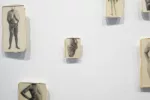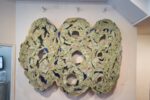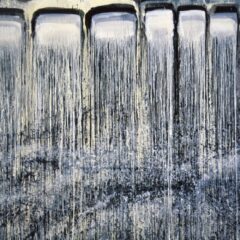[Jennifer discusses a star-inspired show that requires a different way of thinking, good knees, and a flexible evening schedule. –the Artblog editors]
Demetrius Oliver’s exhibition at the Print Center requires viewers to listen to things we can’t hear, to examine closely things we may typically overlook, and to crawl through a dog door. The exhibition title, Canicular, refers to both the canine and the stellar: specifically the star Sirius, known as the Dog Star. In the six works on view here, Oliver presents opportunities for us to forgo our human egos and to adopt a more instinctual or animalistic position from which to view the mysteries of the mundane and the heavenly.
Bringing heaven down to earth
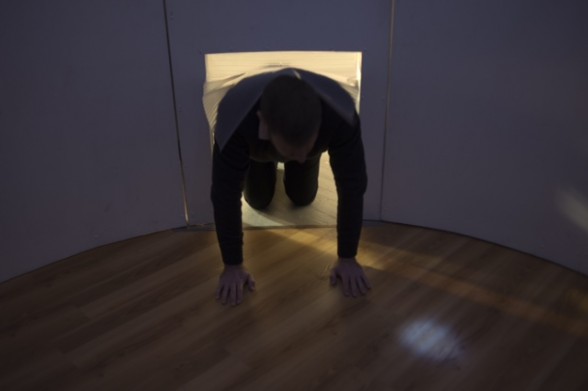
One such opportunity occurs when we crawl, canid-like, through an oversized dog door into the central work of art on view–a round observatory built on the Print Center’s second floor. Projected on a scrim at the top of this small room is Sirius, beamed, somehow, from a high-powered telescope located on the roof of the Franklin Institute.
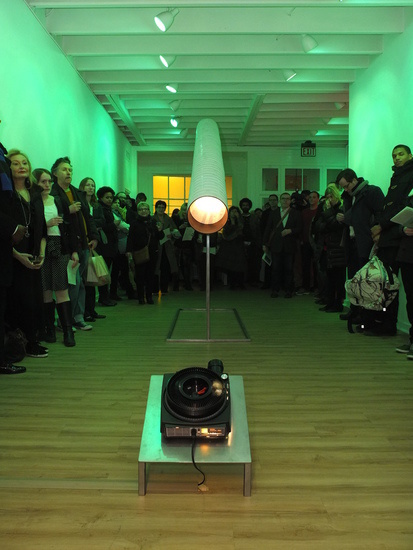
Extracted as it is here from the brilliance of the full night sky, Sirius becomes simply a flickering shape of white light projected on a surface. Could this be a proposal for a new kind of print or photograph somewhere between a still image and a film? Or is this a Magritte-like riddle: is a projection of a star really a star? This piece depends so much on the magnificence of human intelligence and ingenuity, yet by crawling on our hands and knees to enter, we regress to something more infant- or animal-like, to a state where we might forget all this human cleverness and just look.
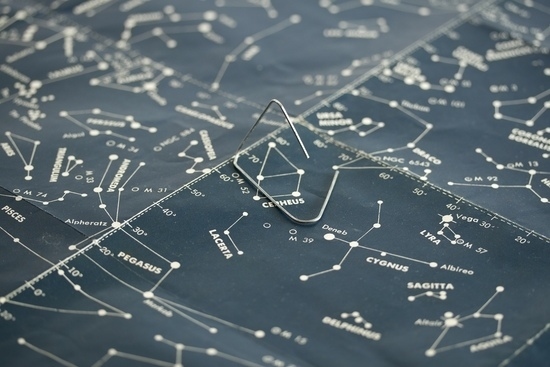
The observatory is a planetarium for a single star, and the resulting effect is intimate; Sirius is brought into very close, earthly proximity. A similar condensing effect occurs in other works, which investigate how mundane human objects can become something akin to solar systems and constellations. “Messier” is a photograph of an unfolded paperclip that has been placed on a constellation map just atop Cepheus. The clip’s bent, rounded triangular shape mimics Cepheus’s triangle. In reforming this paper clip, Oliver is drawing in space a new kind of constellation that is small enough to hold in one’s hand. The clip is now also reminiscent of a triangular sighting tool, through which we can gauge our earthly position in relation to the stars.
A sensory show, dependent on the stars
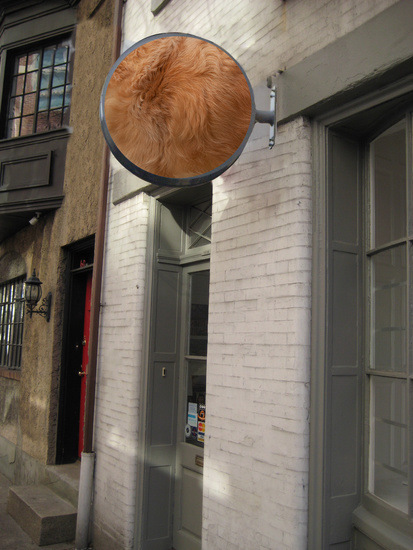
and Demetrius Oliver’s sound installation, “Dwarf,” 2014
How do we gauge our position here in Canicular? In some works, our human senses are altered in a way that seems to purposely confuse possible navigation. A work of art titled “Deutan” consists of red and green lights that mimic red-green color blindness in humans or the typical vision of a dog. We experience this limited spectrum sight when in range of this work. Outside the Print Center, a piece titled “Dwarf” includes a song composed on a dog whistle, which humans can’t hear.
These two examples notably change, suppress, or challenge the human senses. This difficult quality mirrors the challenges and conditions upon which the entire exhibition depends: the show is only open when Sirius is visible in the clear, night sky, typically from 7:00 to 8:00 PM. Only nature decides if we get to see this exhibition at all. Conceding these decisions to the clouds and the stars is a strong institutional critique. It also critiques the human conceit that we are master of our world. Through Canicular, we are reminded that nature remains sovereign, and these works offer opportunities to bow down to her majesty.
Demetrius Oliver’s Canicular is on view at the Print Center, Philadelphia, through March 22; it is typically open, weather permitting, from 7:00-8:00 PM, Tuesdays through Saturdays. Check the Print Center website for daily updates about openings and to find out about a range of programming planned in conjunction with this exhibition.


